Review: Granite Gear Serrano 25L daypack
2013-11-20
By my reckoning this pack is about 3 years old. And to be clear I have put it through the ringer. Around June or so the zipper failed on one side, it's been getting sketchier and sketchier. Sometime in August I realized how bad the seems were and restitched several of them to keep the pack together long enough for some SAR work. I'm finally retiring the pack today.

My uses:
- I carried it to work daily until I quit work. With a laptop in it most days, often jogging, usually cycling.
- When I travelled in civilization I would stuff it packed with a change of clothes, sandals, food, presents, laptop, etc.
- For gear-heavy day-hikes I'd carry this pack with snacks and water
- For weekend 1-2 night trips in warm weather I'd overfill this pack as a weekend backpack. These trips frequently involved heavy bushwhacking.

(This was a trip in Mendocino involving some really heavy bushwhacking and swimming a river several times)
Granite Gear background
Jess has a Granite Gear Meridian Ki which she adores. so much that I actually bought the men's version and used it for a bit before needing to get rid of all my gear. Those packs are for another review though. Granite Gear got their start with A.T. through-hiking packs. They several one of only a few models of pack under 3 lbs that will last the entire length of the trail. The numbers are increasing elsewhere, but ULA and Granite gear were the first really good packs of their ilk. The founders have shown up every year at "trail-days" a backpacking festival on the A.T. and repaired through-hiker's gear for free (any gear, not just theirs). As a result they understand failure modes better than most.
Summary
Wear life
This pack doesn't quite live up to Granite Gear's deserved reputation for robust gear. It's more solid than most packs. In particular the slightly odd shaping of the pack and zippered opening put less stress on the zipper than most designs would, that said... it has a zipper which is virtually always an issue. The fabric is entirely reasonable for this weight of pack, but repeated overstuffing does eventually tear out the seams. I can't really ask *more* from a pack in the price-range and it met my needs for absolutely constant use for 3 years and all the abuse that entails. For most people this would be a life-time backpack. But it's certainly not perfect either and a more robust pack would be nice.
Size
At 25 liters this pack is an incredibly useful size. It carries well massively underloaded which is a very important feature in my book. As a result I carried with everything from a laptop and power-cord, or lunch a rain-coat and a water-bottle, all the way up to a minimal bivy shelter, wood-stove, food for 3 days, warm-coat, etc. on a trip in Lassen. That said, my conclusion is that for my use-case 30 Litres would fit the bill better. At 25L I often overstuff the pack for travelling, as a SAR 24 hour pack, or as a weekend backpacking pack. The extra 5 litres would give me the space to fit that extra bit of food or a minimal shelter into the pack easily.

(Prepping for our impromptu trip in PA a couple weeks ago)
Shape
This pack *looks* totally typical, but the shape is odder than it looks at first glance. Note how the zippered panel goes 2/3's of the way down. It almost looks like it goes to an outer compartment and not the primary one. This, actually, is a really good feature. You can pack really tightly and the stress ends up on the fabric rather than the zipper. You can also get WAY more in the pack than it looks like, that front "bump" gives a huge amount of extra space. It took me a bit to realize it, but basically after the pack *seems* full you can still easilly get a pair of jeans, a shirt, and probably a snack in there. This is part of why the pack carries so well empty, that space slacks out easily leaving some tension in the rest of the pack to help it hold it's shape and keep stuff from shifting. This is especially nice while jogging.
Suspension
I purchased this pack due to external water bottle pockets, a *real* hip-belt with pockets on it, and minimal other pockets in the pack. The hip-belt pockets are wonderful and amazingly didn't wear-through (in contrast to my ULA Circuit). I usually keep a sighting compass, a salt crystal, a headlamp, maybe a sparker, and often iodine in the pockets. This stuff just stays there all the time basically regardless of what I do, and it's always handy while walking or hiking. Having a broad belt is also really nice, when the pack is optimally full, meaning about 3/4 the belt will actually take quite a bit of the load. It's not critical, but definitely nice for long walks. For running a decently wide belt IS critical. The back panel is a thin foam with bumps covered with mesh. This is pretty good. I did tear the mesh some in the time I owned the pack, but in general it rarely caused a problem. It probably helped a bit with getting air to my back, but I'm not actually sure as that's not something I worry about very often. Oh, the mesh over the padding on shoulders kindof frays out a tiny bit, and the mesh itself chafes somewhat, such that if you want to wear it without a shirt, and your shoulders aren't thick-skinned it can be kindof unpleasent.
Water bottle pockets
I don't use water-bladders myself, so this is critical for me. Also, it's nice to have occasionally to stuff a coat into. They aren't quite tall/deep enough. When the pack is empty they carry water bottles very very nicely. When the pack is overstuffed though the bottles get pushed out sometimes, which can be annoying when you have to chase it down the mountain on a rocky scramble.
External Attachment Points
This pack has some tiny little stretchy draws intended for an ice-axe. They are very light while in fact amazingly working quite well for a real ice-axe (I've done this a few times). My only warning though is watch the back of your head, depending how the pack is loaded you may have the spike at the butt end of your axe disturbingly close to the back of your head.
The attachment points work for tons of other things though, and you can pull the stretchy bit off and just throw something else through the nice little webbing loops. Particularly nice is that an ice-axe or hiking poles strapped vertically too the pack do not have to take up the water-bottle pocket and neither do they block entrance via the front lid.
Conclusions
It's a good pack, and for someone with similar criteria to me I'd recommend it. That said it's still on the market I'm not going to get another one. I've decided I'd prefer to move towards canvas and leather. For me a pack like this wears out quite quickly so it's a bunch of plastic to throw in a landfill every 3 years. Canvas or leather is biodegradable and also a lot more repairable. Additionally I've decided my backpacks should not have zippers, particularly for main compartments. Zippers are just to unreliable and hard to repair for my taste. A draw-string is easily field repairable given a knife, a stick, and some fiber, so is most the rest of the pack for that matter particularly if you add a needle to the mix, and a zipper just isn't. After a few attempts to find a pack I decided to build my own, that article should hopefully be coming soon.
(If you decide to get one, please use this link and it will help fund our blog... thanks!)
Impromptu Fall Backpacking
2013-11-04
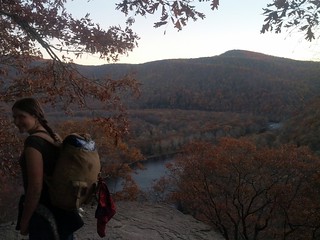
Jess and I have been in Pittsburgh, PA, as mentioned in some previous posts. The last few days we've been hanging out with our friend Greg. This weekend we decided to go backpacking. The obvious first question was "what do we need?". We're in a season in PA now where it drops below freezing every so often. Jess and I have seen snow since getting here. So, our answer was a tarp, twine, sleepingbags, and pads. Later on headlamps and an extra fleece were added as nice-to-haves as well. Minimalism has more uses than just reducing the weight of your pack. There are tons of uses to knowing what you can get away with carrying. Understanding what you actually need can let you go on trips when it's not possible to scrap together a more standard kit.

Greg borrowed 2 sleepingbags and 2 pads from a friend. He had some MREs someone had given him in his basement we used for food. He also had a 11x13 tarp, a smaller tarp useful for a groundcloth, a couple of lengths of twine, a lighter, a sparker, and headlamps for all of us, and an extra fleece for Jess. Greg had basic gear for himself of course. Jess and I had our daypacks, which we'd flown with carryon as our only luggage with no intention of backpacking. We also each had a wool sweater, rain coat, long pants, wool t-shirt, good hiking socks, a hat, and warmish shoes all of which we'd brought as basic clothing just because we knew it'd be cold'ish here. Jess also had tights, and I had a down vest. We packed our clothing and sleepingbags in trash-bags, I tied a closed-cell-foam pad to the outside of my daypack... and we were good to go.

We got a late start so it soon got dark on us, maybe 3 miles in. Everyone in our group enjoyed night hiking though so we continued to over 6 miles before camping at a nice Shelter. The trail was surprisngly difficult to follow at night actually. Not that hard, but there were a lot of crossing roads that would've made for a long of wrong-terms and backtracking with no light. I used a red light a lot time to check blazes, just to be really sure that I didn't lose the trail. Eventually we did use white headlamps though as the light was really failing and there was no moon yet. This trip wasn't about proving anything anyway.
 y
y
(Photo of Greg hiking behind me)

At the shelter we started up a fire and heated up our self-heating MREs. The MREs these days are surprisingly good actually and we had a lot of fun figuring them out. I made a little hot lemonade using my steel water bottle and the lemonade packets from the MREs... no-one else wanted it for some reason, and we talked late into the night.
The next day we had more MREs for breakfast and a beautiful hike out. Given that Jess and I had come to Pittsburgh with just our daypacks with the purpose of going to a wedding it was great to be able to get out with our friend with just a few bits of borrowed gear.
Review: Tacoma as a camper
2013-10-16
We've had Jane (our truck) for some time now, and it just occured to us that we should write a review. The reason this is worthwhile isn't to talk about how great our truck is, but for others thinking of doing something similar there are some details that aren't necessarilly obvious until you try it. So here goes.

We've had Jane for a couple years. I've been living out of the truck since mid may, so about 5 months now. Before that we used her regularly for trips to the mountains, including ski and backpacking trips.
Besides driving places and carrying out junk around with us we have two major additional uses for this vehicle. The first is as a place to sleep in urban areas. The second is as a place to sleep in remote areas in inclement weather or when we don't want to deal with setting up a shelter.
Jane is a manual extended cab 2002 Toyota Tacoma with a 2.7L engine a 2.5" lift I installed myself and a sleeping platform I built. With that dealt with lets get down to the nitty gritty:
The Good
Offroad:
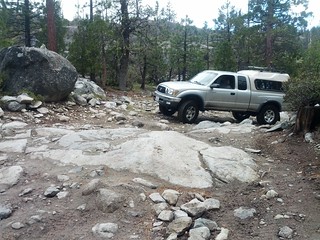 High clearance is AMAZING for boondocking. Recently I was driving across Nevada. The clouds had been making "it's going to rain" patterns all day. It was late and I was ready to sleep. As I drove down the highway I saw on the side a pulloff with a tiny dirt road leading off into the desert... so I took it. In just a couple minutes I was out of view and sound of the highway in the middle of the nowhere in the beautiful Nevada desert. After a nice evening walk I curled up in the back of the truck for a great night's sleep.
High clearance is AMAZING for boondocking. Recently I was driving across Nevada. The clouds had been making "it's going to rain" patterns all day. It was late and I was ready to sleep. As I drove down the highway I saw on the side a pulloff with a tiny dirt road leading off into the desert... so I took it. In just a couple minutes I was out of view and sound of the highway in the middle of the nowhere in the beautiful Nevada desert. After a nice evening walk I curled up in the back of the truck for a great night's sleep.
This is an extremely common story for us. Not driving late at night is a major reason we got the vehicle originally. These sorts of locations are our favourite campsites. The ones where we can really get out and away from people. Where no-one will bother us. Where we're already at a great spot to start hikes, gather food, etc.
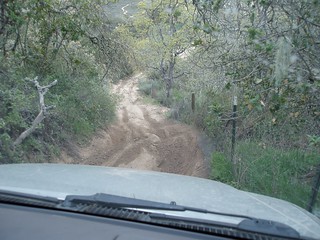 In these cases I need a vehicle that I know will have no problems on my way in. This is where the clearance comes in handy. Jane is a little overkill for this type of case and any reasonable truck or higher-clearance van is sufficient for the bulk of locations. Though I've certainly used the additional clearance a few times. OHV parks can be a great source of boondocking locations for example.
In these cases I need a vehicle that I know will have no problems on my way in. This is where the clearance comes in handy. Jane is a little overkill for this type of case and any reasonable truck or higher-clearance van is sufficient for the bulk of locations. Though I've certainly used the additional clearance a few times. OHV parks can be a great source of boondocking locations for example.
In the Nevada story given the weather there's no way I would've gone down that road without a decent offroad tire and 4wd in addition to the clearance. Had it been a torrential downpour that road could've easily turned to mud, and I'd be stuck waiting for it to dry up... or worse the spot I was in could flood too with my vehicle immobilized. Even after it dries up rain can easily turn a drivable road into a boulder field.
The point is, I don't just need a vehicle capable of getting into great camping spots, but also of capable getting out again. It's not like 4-wheeling where we'd have a friend there to pull us out. The nature of boon-docking is that necessarily no-one knows quite where we are, since we're basically always out searching for campsites. Because of that it's important to have a vehicle that's a little overbuilt. I should note that we also have a small pile of recovery gear such as a highlift jack, saw, and strong rope, along with some decent knowledge of how to use it. The photo below is my clearing a log off a road using a jerk strap.

Note that a low range is absolutely critical. It's all the more so because we slightly upsized the tires (giving the diffs and axles slightly more clearance and the truck a little more traction and flotation). I find myself using low-range particularly frequently in reverse, which is higher than 1'st. Often if I've stupidly gone down a hill on a steep dirt road I end up having to back out. Without a low-range the engine would just die, or even if I could manage to move I'd probably smoke the clutch and move too fast thus running into something.

As a minor note the non-stock rear bumper you see in all the photos has been pretty useful. I've backed into trees a couple of types by accident with no damage being done.
Space:
The platform we've built is really nice. As it turns out it's sufficient to fit two stacked rubbermade boxes underneath, and requires no support structure which would take weight and space. This has been huge for me, and even more useful now that Jess has moved in as well. We gave in and got a storage unit so we can swap out some of our stuff occasionally because even pairing it down we just have too many interests to fit it all. But, as we slowly get organized we can fit not only enough stuff to camp and eat delicious and cheap food, and do SAR, but also some space for gathering, crafts, archery equipment, etc.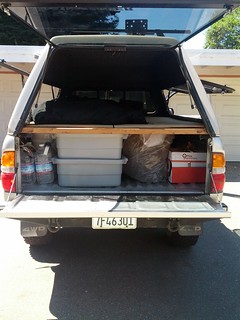
Note that the hightop cap is really necessary for this setup to work well. Otherwise we'd have so little space in the sleeping area that it would be really annoying getting in and out.
Cap:
The windoors are a huge advantage. We frequently reorganize things in the top by opening them and reaching in. In good weather if we aren't stealthing we'll open them up for sleeping as well, which can be very nice. We use the sliding screen windows a lot as well, especially in colder weather where we want the truck cap to breath a little, but we don't want it so drafty.
The carpeting inside the cap has several unexpected advantages. It seems to discourage condensation, so the cap doesn't drip even if we close it all the way up on a cold or rainy night. The carpeting also adds a bit to the insulation ability of the cap, allowing the two of us to heat it up with our body heat in below freezing weather to warm enough we can be relatively comfortable out of our sleepingbags naked. It's not warm not enough to sleep without a bag, but it makes things a lot safer if our bags are compromised or we're wet, it's also just nice. Lastly it works as the passive side of velcro! This means we can stick things to the inside of the cap like curtains, a net to store our curtains, my pee bottle, etc.

Extended cab pickup truck:
Tailgates are AWESOME. It's a place to sit, a place to cook, etc. It means that as soon as you park you've got a surface to work on. It's stable and even extremely useful for woodworking.
Having a seperate cab and sleeping space has some major advantages. For example, if we have something smelly in the back for a short time, we don't smell it in the front. I don't like to put a gas can back there, but it's an option. The heater can warm up the front much faster due to it's size.
We got an extended cab so we could pick up hitchhikers. This and giving rides to friends has come up a number of times, but an additional advantage is the ability to have food and such in the cab. On long roadtrips shotgun can reach around and grab some food or water making everyone happier during the rive.
Downside
Seperate cab and sleeping space
The cab and sleeping space are totally seperate. This means it's not uncommon to wake up in the morning in the cap and look out and see for example that there's snow on the ground and then realize that your shoes are in the cab and there's no way to get to them. It should be noted that on the 2003 model with double sliding windows I could get from the cap to the cab directly by removing the removable front window of the cap. Sadly I don't fit through the rear window of the cab on the '02. oops!
Insufficient space
We still have a storage unit. I've toyed with putting an additional rack over the cab with a basket so we can carry more stuff, but that would impact gas milage and it's not clear that it's worth it. Also, we have to watch the weight bringing us to the next point.Engine is kindof small
Usually this isn't a problem, but it does mean that we really can't tow at all. You have to be pretty aggressive with shifting as well and I've found myself running her at 4000rpm for a time once or twice to keep her going at a safe speed up a hill which will no doubt shorten the engine's lifespane. If it weren't manual it wouldn't be drivable at all when loaded. It also means that when you get her stuck it's trickier to get her out without burning the clutch. This has also limited how much we can load her down with. Adding a roofrack for example wouldn't help us much since we're limited by weight. And lastly it means I can't put any more armor on the truck to protect her when I do something stupid offroad.It's tall
The hight is sufficient with the lift, oversized tires, hightop cap, roofrack, and highlift jack on the roof, that we can't fit in parking structures. This is a very rare annoyance actually, but it's bothered us once or twice at the airport where we can't fit in short-term parking. On the upside, we can spot the truck across a large parking lot no problem, and it's *still* shorter than many vehicle on the road.Other Modifications
Wiring
I added a 12V socket in the back that's always on, this is EXTREMELY useful. I can run a laptop and sit on the tailgate or lie in the back, or I can charge my cellphone overnight.Compass
We have a compass on the front dash. I often look at it when I get a little turned around just to figure out whether a left turn is north or south. For this it really doesn't need to be the precise at all, which is good since the engine creates a variable magnetic field, so it'll never be really precise. I can't tell you how many times I've been driving down a road and said "I wonder if I made a wrong turn" looked down and see I was driving 180 degrees off.Broken door dinger
I intended to bypass it but instead accidentally broke the button. It's a little button on the door that tells the truck if the door is open or not. I like to listen to music while doing some tasks by opening the doors and cranking the stereo... this works poorly if the car is going "YOUR DOOR IS OPEN, YOUR DOOR IS OPEN, PLEASE CLOSE IT!" So I broke that switch. Having broken that switch also caused the automatic dome-light to stop working, but we never used the auto-mode anyway because it blows your night vision when you don't want it too.Keyway "mod"
The keyway also broke such that you can now remove the key while it's ACC mode. This is really useful actually since it means I can unlock the back of the truck while leaving the radio playing or my laptop running off the front sockets. In an automatic this feature would scare me a little... 'cause what if the key falls out and you can't turn the car off! But in a manual you can always just kill the engine easily enough.Conclusions
Overall this has been an amazing vehicle for us, both when living in a house and when living in the truck. I can't see ever owning a vehicle with this purpose that isn't 4wd and high-clearance, and even the extra lift has been completely worth it for the extra safety factor it gives us. The gas mileage is great, and having it be compact enough to get down tiny roads is incredibly useful. I love the lack of power windows and such and the ability to do things like roll the windows down after the car is off. If we were to do it again Jess and I agree that we'd probably go for the larger 3.4L 6-cyl despite it being marginally less reliable. I'd also try and find one with break-away mirrors. So far we haven't smashed one of ours, but it make me nervous having them hard-mounted to the body.
The vehicle is relatively subtle. It's obviously a lifted truck so not super subtle in some cities, but out in the country it's a vehicle people expect to see in random places. This is very useful when stealthing.
Gas milaage is about 19mpg. Not bad for an offroad house. Will we live in it forever? No, probably not. Will we keep using similar vehicles for camping, road-trips, and even months of travelling? It's pretty likely, at least until we decide to do everything by mule ;D.
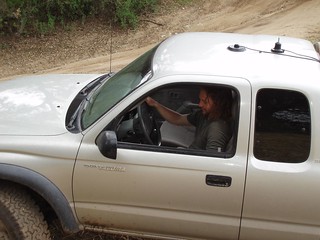
In Civilization for a bit
2013-10-10
Jess and I are reuinited and visiting civilization for a bit. Right now we're in the Bay Area, but we'll be in Pittsburgh in a couple of weeks. We have some social functions to attend, and now that both of us need to fit in the truck we have a great gear-reorganization that we plan to dive into today.
Our more detailed plans cease about here. We've been discussing trying to find some land within a few hours drive of the bay area to hole up for the winter in a walltent or similar, work on a couple projects, and play with a slightly less nomadic way to live with the land. So, if you have leads on that it'd be awesome if you drop us a line or comment here! We're also certainly open to other outdoor activities like say leading trips, horse logging internships, rescue-related work, etc. We've got a little time before it'd be nice to know where we're headed next.
Jess is still readjusting to concepts like indoor spaces, and hopefully doesn't get TOO used to it :P. She learned a ton of fascinating stuff this summer (I find it fascinating at least) that she wants to share here on the blog. So, hopefully there should be a lot of interesting content on the more primitive end of things coming soon. Topics like tanning hides, making buckskin clothing, dealing with a month of rain with no tarps and little other shelter, wild foods, small towns, group dynamics, etc.
Advanced Swiftwater Rescue
2013-10-10
I took another rescue class. This is the third class in a set of 3. TRR, SRT-1 and now SRT-A. TRR is Technical Rope Rescue. SRT-1 is swiftwater rescue technician level 1. And this class was the Swifwater Rescue Technician Advanced class. You can see my previous two posts for the last two classes:
- http://www.blog.smalladventures.net/2013/05/technical-ropes-rescue-technician-level.html
- http://www.blog.smalladventures.net/2013/08/swiftwater-rescue-technician-course.html .
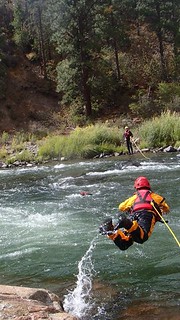
Unlike SRT-1 I don't think everyone needs to take this course. This class is intended really only for rescuers. While it's awesome to know more and I wouldn't discourage anyone, it's just not necessary for most people to have these skills. I took the series mostly out of curiousity and interest, but also so I could bring back some of the knowledge to my team CalESAR (which doesn't do swiftwater rescue), and lastly to rack up a few cool certifications that might help me get neat jobs. The end result is that I'm now certified to be in the water for complex rescues, such as those in class 3 rapids. So that's kindof cool.
Day 1
This was a 3 day class. We started by practicing swimming rapids and moving around in the river. I actually picked up a lot more about how water behaves. I was quite surprised to find that I could swim up eddies only a couple of feet across... pretty cool! Once again It's driven home that while brute force helps, it's rarely the best answer in rescue.
Here's a cool action shot of a class-mate. I believe this is while practising moving across a river.

We also did a few scenerios in the afternoon involving relatively simple rescues rapidfire. We had a few interesting occurances. I yet again learned that being IC is hard. I was trying to do the right thing and not get into the water much, but our class was only 6 people. We couldn't see the victim. I sent 3 to investigate and kept 3 as backups to see what happened. Well... basically the 3 dove into trying to rescue them and they had a very hard time calling back to shore for resources. In the end, I should've gone out to the island given the limited people available... oops! Lesson learned.
Later on in another scenerio. I ended up doing a live-bait rescue in some relatively heavy rapids, that was pretty fun. We'd tried to cross a rope but my first throw failed. IC at the time suggested a live-bait and asked if I could do the swim. It was on the edge for what I could do reliably (not that dangerous, just hard to actually get where I needed to be), but it worked... yay!
In the process of course we practiced throwbagging, live-bait rescue, swimming rapids, lassoing patients, and simple/fast river-crossing techniques (say, a quick rope across the river at an angle that people ride on caribeaners).
Day 2
I may have the order of events wrong, but I'm having trouble remembering for sure. In the morning we reviewed knots and the like, and a bit before lunch we rigged a highline tyrolean as a way to control a boat in the river. In the photo we were pretending the river was too wide to throw across, so we were using a combination of live-bait (me) and someone on the other side throwing to safely cross the rope farther than the person could throw.
The highline lets you get point accurate in the river on a platform, making the rescue a lot more static which is always good. It's a LOT of setup though, so no good if the patient isn't "stable" (in swiftwater this means head above water). It took us about an hour total to get set up, about 30 minutes of actual rigging after 30 minutes of discussion and gear allotment. The picture at the top is actually of me as we're crossing the highline. To get it across we used throwbags.

I was the first in the boat and quickly found that while it looks like the rope would decide where you are in the river, it's not that simple. The rope only does anything when taut. The thing to realize is not all of the water in the river is going downstream, when in an eddy nothing is pushing the boat downstream and the rope goes slack. So while this rigging helps enormously with controlling the boat and holding it in place in rapids, it has to be augmented by paddling and an understanding of what's going on in the river to make it work.
We also played on riverboards a bit, which is a great way to help understand the river, and a useful rescue tool as well.

That evening we had a night search planned. It was snowing on us by this point. And one group managed to lock themselves out of their car due to a "feature" where it sometimes decides to lock itself. So, we helped them break into their car again (hooray for carrying lots of tools in the truck) and everyone scooted off to find themselves dinner.
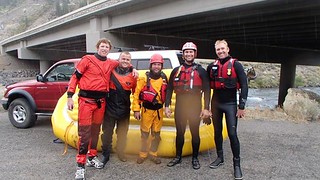
I realized as I warmed up during the drive that I had entered cold stupid. That is, I wasn't thinking very straight anymore due to being cold. I missed an easy toss earlier that day due to cold hands, and now it was catching up to me. I'm really glad I had a drysuit. Eventually I found a place to eat and stuffed my face as fast as I could, I was starving presumably from burning calories to stay warm and swim in rapids. Then I grabbed a cup of hot cocoa at starbucks and chilled out for a bit. I felt a lot better by the time I drove to the site for the night search.
The night search was on a calm piece of river. Our instructor Zach, realizing it was cold, restricted the IC to only using those of us with drysuits (2 people) as water rescuers, the rest had to stay on the bank. The bank rescuers actually found the victim, but since he was right next to the water decided to hand off medical to us and they ran up and started rigging for a low-angle extraction. After a lot of huffing a puffing and of course some mistakes we got the guy out safe, and no-one got too cold.
Day 3
On the 3'rd day we did no water at all. Instead after some administrative stuff we went to a different site and rigged a highline with a midpoint drop for actually lowering people. This highline being fairly sloped could also be properly termed an "offset" line.

Note the control line running from the highline down to the rescuer in the photo. That's the midpoint drop. If you look at the photos from my TRR class we didn't do the midpoint drop, instead we adjusted the tension of the highline to lower and raise the rescuer.
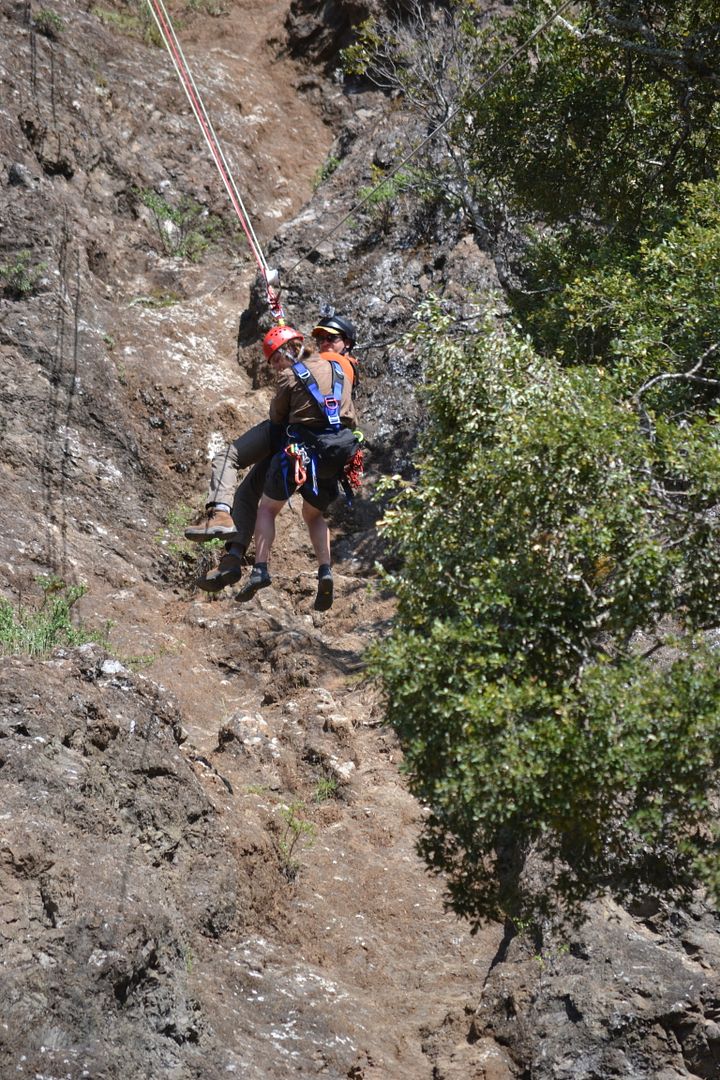
That technique works well in some situations, but you can see here the sides of the canyon are too steep to slack the highline, it would rub on the rocks.
Below is a photo of me operating the control line. There's also a "tag" line on the top side of the highline used to control where the carriage is on the highline. That is, the tag-line controls left-right, and the control-line controls up-down.

This was a pretty interesting class. I didn't have a lot of expectations going into it, but I definitely learned a lot and I'm really glad I took it. I feel a lot more confident about my understanding of more complex rigging and water rescues both. That said, if you aren't into Rescue this is probably not the place to spend your time and money.
Camping
As an interesting side-note I discovered that campgrounds in Tahoe in the off season are essentially free. They don't have Iron Rangers (places to just drop your money) and you are expected to pay a campground host who will stop by your site. Well, in the off season there is no host, so no way to pay for your site even if you wanted to. As a result I boondocked one night at a site I found during my WFR course a while back, and the rest of the time slept in campgrounds for free.
More photos: https://www.facebook.com/sierra.rescue.7/media_set?set=a.584466978280483.1073741891.100001515572160&type=

